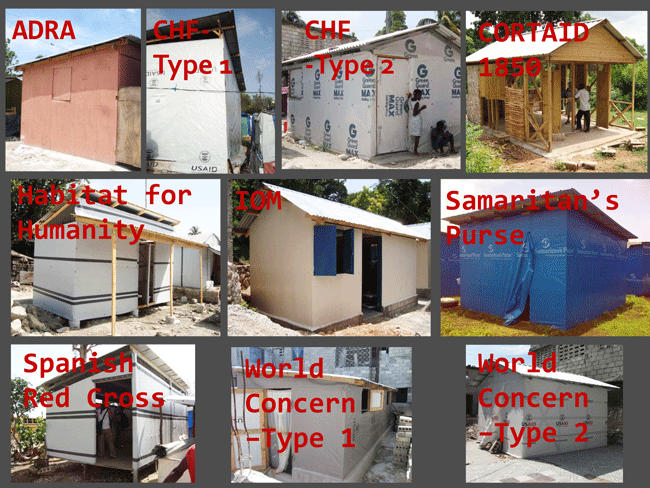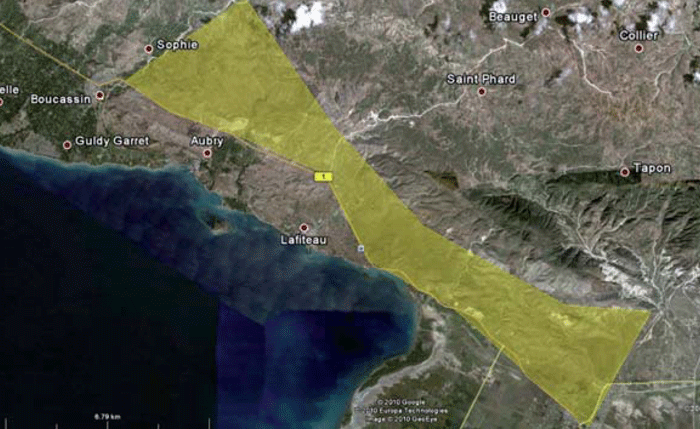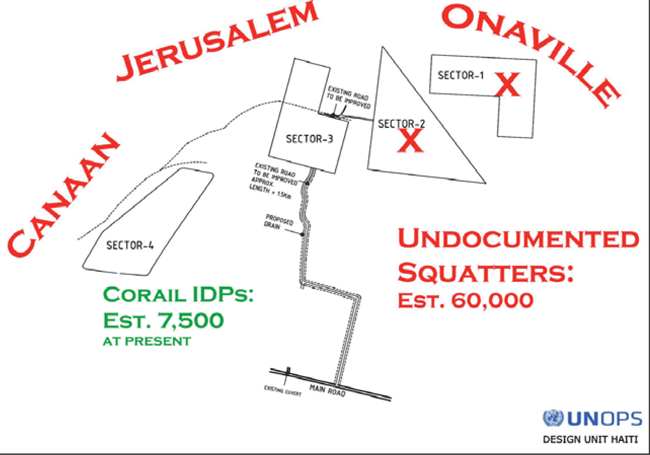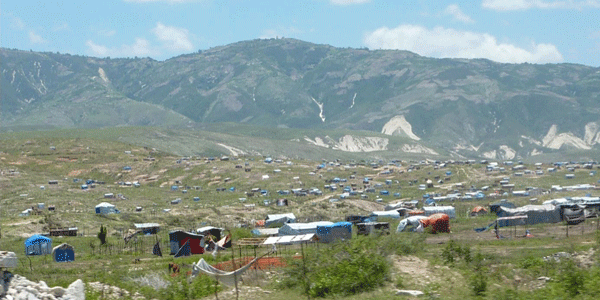“Transition to what?”
part 1 of 3
Léogâne, 23 August 2011 – Blue, pink, white or green. Plastic, plywood, steel, two-by-fours. These are the colors and materials that make up the almost 90,000 tiny houses dotting the hillsides of Haiti’s slums and countryside in the earthquake zones.
But who is getting a “T-Shelter,” so-called because it is “temporary” or “transitory”? And, as one United Nations agency director said, concerning T-Shelters – “Transition to what?”
What is a T-Shelter?
A T-Shelter is a small house built by humanitarian agencies and organizations as part of the standard post-disaster toolbox.
“Transitional shelter is used to house affected households with habitable, covered living space and a secure, healthy living environment with privacy and dignity during the period between a natural disaster and the availability of a permanent shelter solution," according to Safer Homes, Stronger Communities, the World Bank-sponsored "[h]andbook for reconstructing after natural disasters."

Source: Shelter Cluster (November, 2010)
The construction of transitional housing for displaced people is one of two periods after a catastrophe. The first is distribution of emergency shelter, like tents, and the second is the building of emergency structures (“T-Shelters”), which precedes the construction of permanent housing.
On average, a T-Shelter is one room measuring between 12 to 18 square meters, and built to last at least three years.
It’s lifespan depends on how it is planned and built, because some are simply wooden posts with plastic sheeting, sometimes without doors or windows, while others have a wooden or metal frame, with plastic or wooden walls. Almost all, although not 100 percent, have tin roofs. Some are called “semi-permanent” because the foundations and walls can become part of a larger, permanent home, assuming the beneficiaries have the economic means to make those changes.
The also vary in terms of cost. The price can run from $1,200 plus labor, like the steel-frame-and-plastic shelters provided by Cooperative Housing Foundation International, all the way up through US$4,300, and the price tag might be even higher. The “Shelter Cluster” – the United Nations system that should coordinate, but that does not have coercitive power over, the humanitarian agencies working on shelter issues – attempted to get hard figures for a recent study, but didn’t always succeed. (Le Cluster system is used by humanitarian agencies after catastrophes. See The Cluster System in Haiti for more details.)

Differing types of T-Shelters. Prices run up to US$4,300. Source: Shelter Cluster
“Agencies were reluctant to share their cost data,” Regan Potangaroa, who worked on one study, explained to Haiti Grassroots Watch (HGW) in an email.
As of early August, the agencies had built 89,705 T-Shelters, about 30,000 of which are in the Palms region: the coastal zone west of the capital.
Although only a ballpark figure, it’s safe to project that at least US$200 million, and likely about US$300 million, will have been spent on T-Shelters once they are all constructed.
Denigrated as « chicken coops » or « cages à pigeons » by some, and even by officials like Marc Roland Justal, le mayor de Petit-Goâve, thousands of families are grateful to be out of the squalid, overcrowded and dangerous camps, even if they are squeezed into one room with plastic walls.
But, T-Shelters usually don’t go to Haiti’s poorest…
However, not everybody gets a T-Shelter. In most cases, only those with a land title can get one.
And, according to the most recent figures from the International Organization for Migration (IOM), published in an August, 2011, study, 62 percent of the 634,000 displaced people living in the 1,001 camps – almost 400,000 people – were renters before the earthquake.
In a study by HGW journalists, in nine camps in the Palms region, of 20 people interviewed, 18 said they had been renters. Most of them also reported that agencies had distributed T-Shelters to some of the residents of their camps.
“Only the refugees who have land get a T-Shelter. So far they haven’t said anything to the people who don’t have land,” Sam Brignol, a refugee at the Gérard Christophe Park camp, said.
Brignol knows because, at the time this article was being prepared, he was living that reality. In his camp, housing about 200 or so families, the Lutheran World Federation [LWF] is providing 100 households with what they call “semi-permanent” shelters to landholders.
“After this series of 100, the LWF will examine the possibility [highlighted by LWF] of constructing other shelters, however, we can’t make any promises. That will depend on the funding and the funding sources for this project,” LWF’s Jean Denis Hilaire told HGW in an email.

Map of agencies doing housing-related work in the Léogâne region. Source: Shelter Cluster
The Land Question
All the humanitarian actors – from the agencies on the ground, all the way up to the highest levels of the Interim Haiti Recovery Commission (IHRC) – recognize that complications around land tenure in Haiti represent a major, perhaps the major, stumbling block.
Dr. Louis O. Dorvilier, FLM country director, told HGW that, in addition to having their building materials delayed in Haitian customs for seven months, local and national authorities in Léogâne have not been able to make land available for planned, temporary settlements where former renters would also be housed in T-Shelters.
“Since the beginning, the LWF has worked with local and central authorities to try to find a sustainable solution for the population,” Dorvilier said in an email.
In nearby Gressier, where five hectares of land was made available, LWF is building – with local participation – an “integrated village with decent housing, sanitary, electric (renewable energy) and water installations, a community center, a play ground” and zoning for small businesses, according to Dorvilier. LWF sees the project as an example of “rebuild better and rebuild with dignity.”
“We could have done the same thing in Léogâne, but the land wasn’t available,” he added.
Jean-Christophe Adrian, director of UN-HABUTAT, the United Nations agency concerned with human settlement, and the agency which leads the “Shelter Cluster,” calls the land issue a “major obstacle” for every phase of reconstruction – from beginning to end.
“They don’t give transitory housing to anyone who is not a landowner,” Adrian confirmed, with frustration.
In many regions of the country, other humanitarian organizations tried to get land in the same manner as LWF by asking the authorities to declare land “of public usefulness” so that earthquake victims could be housed, but in many cases, the attempts were in vain.
“We didn’t succeed,” explained Catherine Lefebvre, former Shelter Cluster leader for Petit and Grand Goâve and for the Southeast.
“The authorities didn’t give land for the earthquake victims. The humanitarian agencies can’t take this action. The authorities need to do it. Give us the land, we can build and we will build. It’s always the same land problem,” she said indignantly.
However, it’s not impossible. The “village” of Gressier and several planned camps – like Tabarre Issa and Corail Cesselesse, which together house almost 6,000 families – are just a few of the examples of settlements where the government go involved to either declare land « of public utility« or to outright rent it from its owner.
But if not done well, chaos can result.
In 2010, the René Préval government declared a 5,000 hectare tract – much of it reportedly privately owned – “of public utility” so that humanitarian actors to establish the Corail-Cesselesse planned settlement on 42 hectares. Nothing was announced for the rest of the land, but within weeks, squatters began arriving. Today, some 60,000 people live in tents and shacks on the arid, rocky slopes.

Land north of the capital declared "of public utility." Souce: UNOPS

Map of Corail settlements. Source: UNOPS

Settlers' homes in Canaan.
“It is impossible to overstate the degree to which the land ownership situation in Haiti contributed to the impact of the earthquake and to the complexity of reconstruction,” Priscilla Phelps, IHRC Senior Housing and Neighborhoods Advisor and co-author of the World Bank post-disaster housing book, told HGW.
Indeed, the IHRC website makes a public plea to the government for a more proactive approach to the land issue, proposing that it “complete[s] or abandon[s] appropriations processes for land declared of public utility” as well as “establishe[s] procedures to ensure tenure rights in enumerated informal neighborhoods.”
Leaders will need to be determined and tireless if they want to find a long-term solution to Haiti’s land issue, according to Bernard Ethéard, General Director of the National Institute for Agrarian Reform (INARA in French).
In an interview with HGW last year, Ethéard posited that most land in Haiti is actually state land that has been stolen or given away by almost 200 years of dictators and tyrants. Consulted by the government after the earthquake, he recommended “state verification of all land titles” and in the meantime, “outlaw all land dealings.” [Read What is the plan for Haiti's 1.3 million homeless? for more from Ethéard, and for background]
Not surprisingly, that advice has not yet been followed.
End of part 1
Go to part 2 - Corruption and other challenges
Go to “Being Broke is Nothing”
Return to the Introduction and watch the video

